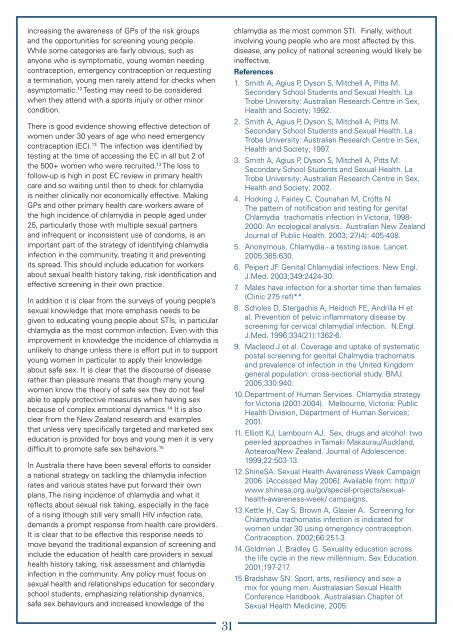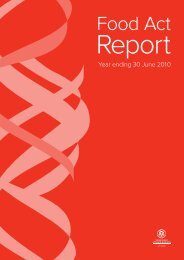Public Health and Communicable Diseases - SA Health - SA.Gov.au
Public Health and Communicable Diseases - SA Health - SA.Gov.au
Public Health and Communicable Diseases - SA Health - SA.Gov.au
You also want an ePaper? Increase the reach of your titles
YUMPU automatically turns print PDFs into web optimized ePapers that Google loves.
increasing the awareness of GPs of the risk groups<strong>and</strong> the opportunities for screening young people.While some categories are fairly obvious, such asanyone who is symptomatic, young women needingcontraception, emergency contraception or requestinga termination, young men rarely attend for checks whenasymptomatic. 12 Testing may need to be consideredwhen they attend with a sports injury or other minorcondition.There is good evidence showing effective detection ofwomen under 30 years of age who need emergencycontraception (EC). 13 The infection was identified bytesting at the time of accessing the EC in all but 2 ofthe 500+ women who were recruited. 13 The loss tofollow-up is high in post EC review in primary healthcare <strong>and</strong> so waiting until then to check for chlamydiais neither clinically nor economically effective. MakingGPs <strong>and</strong> other primary health care workers aware ofthe high incidence of chlamydia in people aged under25, particularly those with multiple sexual partners<strong>and</strong> infrequent or inconsistent use of condoms, is animportant part of the strategy of identifying chlamydiainfection in the community, treating it <strong>and</strong> preventingits spread. This should include education for workersabout sexual health history taking, risk identification <strong>and</strong>effective screening in their own practice.In addition it is clear from the surveys of young people’ssexual knowledge that more emphasis needs to begiven to educating young people about STIs, in particularchlamydia as the most common infection. Even with thisimprovement in knowledge the incidence of chlamydia isunlikely to change unless there is effort put in to supportyoung women in particular to apply their knowledgeabout safe sex. It is clear that the discourse of diseaserather than pleasure means that though many youngwomen know the theory of safe sex they do not feelable to apply protective measures when having sexbec<strong>au</strong>se of complex emotional dynamics. 14 It is alsoclear from the New Zeal<strong>and</strong> research <strong>and</strong> examplesthat unless very specifically targeted <strong>and</strong> marketed sexeducation is provided for boys <strong>and</strong> young men it is verydifficult to promote safe sex behaviors. 15In Australia there have been several efforts to considera national strategy on tackling the chlamydia infectionrates <strong>and</strong> various states have put forward their ownplans. The rising incidence of chlamydia <strong>and</strong> what itreflects about sexual risk taking, especially in the faceof a rising (though still very small) HIV infection rate,dem<strong>and</strong>s a prompt response from health care providers.It is clear that to be effective this response needs tomove beyond the traditional expansion of screening <strong>and</strong>include the education of health care providers in sexualhealth history taking, risk assessment <strong>and</strong> chlamydiainfection in the community. Any policy must focus onsexual health <strong>and</strong> relationships education for secondaryschool students, emphasizing relationship dynamics,safe sex behaviours <strong>and</strong> increased knowledge of thechlamydia as the most common STI. Finally, withoutinvolving young people who are most affected by thisdisease, any policy of national screening would likely beineffective.References1. Smith A, Agius P, Dyson S, Mitchell A, Pitts M.Secondary School Students <strong>and</strong> Sexual <strong>Health</strong>. LaTrobe University: Australian Research Centre in Sex,<strong>Health</strong> <strong>and</strong> Society; 1992.2. Smith A, Agius P, Dyson S, Mitchell A, Pitts M.Secondary School Students <strong>and</strong> Sexual <strong>Health</strong>. LaTrobe University: Australian Research Centre in Sex,<strong>Health</strong> <strong>and</strong> Society; 1997.3. Smith A, Agius P, Dyson S, Mitchell A, Pitts M.Secondary School Students <strong>and</strong> Sexual <strong>Health</strong>. LaTrobe University: Australian Research Centre in Sex,<strong>Health</strong> <strong>and</strong> Society; 2002.4. Hocking J, Fairley C, Counahan M, Crofts N.The pattern of notification <strong>and</strong> testing for genitalChlamydia trachomatis infection in Victoria, 1998-2000: An ecological analysis. Australian New Zeal<strong>and</strong>Journal of <strong>Public</strong> <strong>Health</strong>. 2003; 27(4): 405-408.5. Anonymous. Chlamydia - a testing issue. Lancet.2005;365:630.6. Peipert JF. Genital Chlamydial infections. New Engl.J.Med. 2003;349:2424-30.7. Males have infection for a shorter time than females(Clinic 275 ref)**.8. Scholes D, Stergachis A, Heidrich FE, Andrilla H etal. Prevention of pelvic inflammatory disease byscreening for cervical chlamydial infection. N.Engl.J.Med. 1996;334(21):1362-6.9. Macleod J et al. Coverage <strong>and</strong> uptake of systematicpostal screening for genital Chalmydia trachomatis<strong>and</strong> prevalence of infection in the United Kingdomgeneral population: cross-sectional study. BMJ.2005;330:940.10. Department of Human Services. Chlamydia strategyfor Victoria (2001-2004). Melbourne, Victoria: <strong>Public</strong><strong>Health</strong> Division, Department of Human Services;2001.11. Elliott KJ, Lambourn AJ. Sex, drugs <strong>and</strong> alcohol: twopeer-led approaches in Tamaki Mak<strong>au</strong>r<strong>au</strong>/Auckl<strong>and</strong>,Aotearoa/New Zeal<strong>and</strong>. Journal of Adolescence.1999;22:503-13.12. Shine<strong>SA</strong>. Sexual <strong>Health</strong> Awareness Week Campaign2006. [Accessed May 2006]. Available from: http://www.shinesa.org.<strong>au</strong>/go/special-projects/sexualhealth-awareness-week/campaigns.13. Kettle H, Cay S, Brown A, Glasier A. Screening forChlamydia trachomatis infection is indicated forwomen under 30 using emergency contraception.Contraception. 2002;66:251-3.14. Goldman J, Bradley G. Sexuality education acrossthe life cycle in the new millennium. Sex Education.2001;197-217.15.Bradshaw SN. Sport, arts, resiliency <strong>and</strong> sex- amix for young men. Australasian Sexual <strong>Health</strong>Conference H<strong>and</strong>book. Australasian Chapter ofSexual <strong>Health</strong> Medicine; 2005.31
















